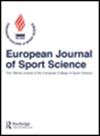Effects of a structured midsole on spatio-temporal variables and running economy in overground running
IF 3
3区 医学
Q2 SPORT SCIENCES
引用次数: 14
Abstract
Abstract Research to enhance running performance has led to the design of a leaf spring-structured midsole shoe (LEAF). In treadmill running, it has been shown that LEAF led to an increased running economy and increased stride length (SL) through a horizontal foot shift during stance compared to a standard foam shoe (FOAM). The purpose of this study was to analyse whether (a) these findings can also be observed in overground running and (b) relations exist between spatio-temporal variables and running economy. Ten male long-distance heel-strike runners ran at their individual 2 mmol/l blood lactate speed with LEAF and FOAM in randomized order. Kinematic data were recorded with an inertial measurement unit synchronized with 2D video. Oxygen consumption was measured using an automated metabolic gas analysis system. Blood lactate was collected after each run. The strike pattern was unaffected by LEAF. SL was increased by 0.9 ± 1.1 cm (95% CI 0.2 to 1.5; p = .040; dz = 0.76), stride rate (SR) was reduced by −0.4 ± 0.3 strides/min (95% CI −0.6 to −0.1; p = .029; dz = 0.82) and oxygen consumption tended to be reduced by 1% (−0.4 ± 0.6 ml/min/kg; 95% CI −0.8 to 0.0; p = .082; dz = 0.62) when running with LEAF compared to FOAM. Changes in oxygen consumption in LEAF were correlated with SL (r = 0.71; p = .022) and SR (r = −0.68; p = .031). It can be concluded that LEAF has the potential to cause small changes in spatio-temporal variables during running. Runners increasing SL and decreasing SR in response to LEAF can achieve small improvements in running economy, which is beneficial in terms of performance.结构中底对地上跑时空变量及跑经济性的影响
为了提高跑步性能,设计了一种叶弹簧结构的中底鞋(leaf)。在跑步机上跑步时,与标准泡沫鞋(foam)相比,LEAF通过站立时的水平脚移位,增加了跑步经济性和跨步长度(SL)。本研究的目的是分析(a)这些发现是否也可以在地上跑步中观察到,(b)时空变量与跑步经济性之间是否存在关系。10名男性长距离足跟跑者按个人2 mmol/l血乳酸速度随机服用LEAF和FOAM。运动数据由与二维视频同步的惯性测量单元记录。使用自动代谢气体分析系统测量耗氧量。每次跑步后采集血乳酸。罢工模式不受LEAF的影响。SL增加0.9±1.1 cm (95% CI 0.2 ~ 1.5;p = 0.040;dz = 0.76),步幅率(SR)降低- 0.4±0.3步/分钟(95% CI - 0.6 ~ - 0.1;p = 0.029;Dz = 0.82),耗氧量趋于降低1%(- 0.4±0.6 ml/min/kg;95% CI−0.8 ~ 0.0;p = 0.082;dz = 0.62),与FOAM相比。叶片耗氧量变化与SL相关(r = 0.71;p = 0.022)和SR (r = - 0.68;p = .031)。由此可见,LEAF在运行过程中有可能引起时空变量的微小变化。跑步者通过增加SL和降低SR来应对LEAF,可以在跑步经济性方面取得微小的改善,这对表现是有益的。
本文章由计算机程序翻译,如有差异,请以英文原文为准。
求助全文
约1分钟内获得全文
求助全文
来源期刊
CiteScore
6.60
自引率
3.10%
发文量
153
审稿时长
6-12 weeks
期刊介绍:
The European Journal of Sport Science (EJSS) is the official Medline- and Thomson Reuters-listed journal of the European College of Sport Science. The editorial policy of the Journal pursues the multi-disciplinary aims of the College: to promote the highest standards of scientific study and scholarship in respect of the following fields: (a) Applied Sport Sciences; (b) Biomechanics and Motor Control; c) Physiology and Nutrition; (d) Psychology, Social Sciences and Humanities and (e) Sports and Exercise Medicine and Health.

 求助内容:
求助内容: 应助结果提醒方式:
应助结果提醒方式:


